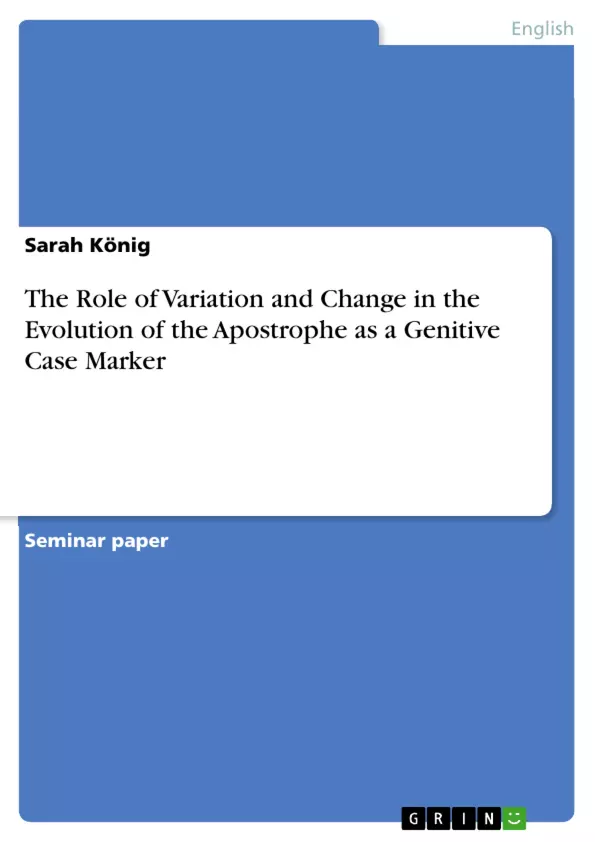This paper explores one of the pecularities of the English language: The use of the apostrophe as a genitive case marker. In tracing the historical development of genitive marking by means of the apostrophe, the contributing role of different variants and changes are discussed, namely the his-genitive and the development of phrasal genitive marking.
Additionally the evolution of various functions of the apostrophe is taken into account, thus attempting to answer the question of why the English language would come to adopt a diacritical sign as a method of genitive case marking. The main historical focus lies on Early Modern English as a pivotal time in this development. As the evolution of the apostrophe as a genitive marker was not concluded in this period, the paper assesses its development up to contemporary language use.
Table of Contents
- Introduction
- The Development of English Orthography and Punctuation: Origins of the Apostrophe
- Determining the Status of the Apostrophe and its Transition Period
- Factors Influencing the Evolution of the Apostrophe in the Genitive
- The Role of Proper nouns ending in -a or -o
- The Role of the his-genitive
- The Development into a Phrase Marker
- The Apostrophe as a Genitive Marker in the Plural
- Conclusion: The future of the genitive apostrophe?
- References
Objectives and Key Themes
This paper examines the development of the apostrophe as a genitive marker in English, particularly focusing on the Early Modern English period. It aims to demonstrate how variations and changes in the genitive contributed to the current use of the apostrophe. The paper investigates the historical context of the apostrophe's emergence, exploring its origins and its evolving roles in written English.
- The role of orthographic and punctuation developments in the rise of the apostrophe
- The transition of the apostrophe from a symbol of letter elision to a genitive marker
- The impact of various factors on the evolution of the apostrophe, such as the his-genitive and proper nouns ending in -a or -o
- The extension of the apostrophe from a singular genitive marker to the plural
- The gradual acceptance of the apostrophe as a genitive marker by grammarians and writers.
Chapter Summaries
- Introduction: Introduces the topic of the apostrophe as a genitive marker in English and highlights the lack of extensive research on its development. It emphasizes the importance of studying the Early Modern English period due to its significant transitional phase in English grammar and the increasing focus on orthography and punctuation.
- The Development of English Orthography and Punctuation: Origins of the Apostrophe: Explores the evolution of English orthography and punctuation, particularly in the context of the printing press and the influence of logographic and phonetic spelling. It examines the origins and early functions of the apostrophe, tracing its introduction through Latin, Italian, and French influences.
- Determining the Status of the Apostrophe and its Transition Period: Discusses the gradual transition of the apostrophe from a sign of letter elision to a genitive marker, highlighting the complexities and inconsistencies in its usage during the 17th and 18th centuries. It examines the views of contemporary grammarians and their role in shaping the understanding of the apostrophe's functions.
Keywords
This study focuses on the evolution of the apostrophe as a genitive marker in English, exploring key themes such as Early Modern English orthography, punctuation, letter elision, grammatical change, and the influence of grammarians on linguistic development. It examines the role of the his-genitive, proper nouns ending in -a or -o, and the transition from singular to plural genitive marking.
- Quote paper
- Sarah König (Author), 2014, The Role of Variation and Change in the Evolution of the Apostrophe as a Genitive Case Marker, Munich, GRIN Verlag, https://www.grin.com/document/314132



